It was raining as we left the campsite this morning and continued along the almost deserted sea road towards Stavanger. This area has been partially cleared of the masses of rounded granite boulders, which have been used to construct dry stone walls, similar to those found on Dartmoor. It was our first sight of farming in Norway with fields of potatoes, carrots and cabbages to the landward side of the sea road and a jumble of rocks and boulders on the seaward side. The road runs along through a flat, sandy landscape with the line of the sea to our left. Beside the shore cattle wander amongst the boulders. There seems little enough there for them to eat. From time to time we would see a fishing croft, right on the shore. Constructed from granite and wood they have grass growing on the roof.
 Fishing croft with grass on the roof, Norway
Fishing croft with grass on the roof, NorwayWe turned inland at Nærbo to seek out what looked to be an interesting museum about iron. When we arrived we realised our Norwegian had tricked us just as our Danish had. It was in fact a museum of bygone days and anyway it wasn't open. However, we took a little walk in the rain beside a small river. With the granite stone walls, the wild autumn fruits, the rowan trees and the sound of sheep bleating, we could imagine ourselves already transported back to Devon. The mizzling rain only added to the atmosphere of home in a landscape far less dramatic than yesterday, but very lovely just the same.
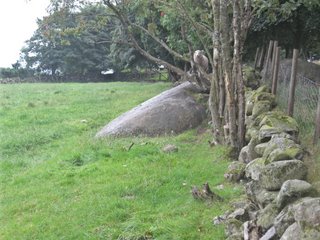 Norway, not Devon! Nærbo
Norway, not Devon! Nærbo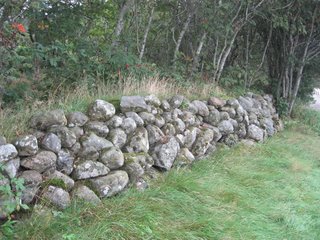 Drystone wall, still not Devon! Nærbo
Drystone wall, still not Devon! NærboWe have discovered that drivers need to pay a toll to enter certain administrative areas. We pulled off to feed an unmanned machine with 13 kroner (c£1.20) and received a ticket valid for an hour. The machines do not give change so you need the exact money. Norwegian drivers simply drive through but they all seem to have a barcode fixed to their number plate and cameras operate at the toll points. We presume they pay periodically or that the charge is automatically deducted from their credit card.
We continued to the town of Sola. We were under the impression that it was a nice coastal town. In fact it is the main airport for Stavanger. It is a very dull and dreary place. Stopping for vegetables at a supermarket we noticed a lady feeding a recycling machine with returned bottles and drinks cans. We asked if we could watch and she explained how the system works. Every item purchased has a surcharge of one kroner added to the cost – i.e. your lager six-pack has six kroner added. When fed into the machine, a barcode scanner adds them all up and gives a receipt which you have to either spend in the store or queue up at the check-out for a refund. Our lady was due 35 kroner on her little lot.
Incidentally, as in so many countries, prices in supermarkets are marked e.g. 9.90 kroner as it sounds so much cheaper than 10. However, there is no small change available so the purchaser is obliged to pay above the actual price for a single item. This has already happened several times to us. It does not seem right that pricing can be so arranged as to make it impossible to give the correct change.
On the edge of the town we stopped for diesel as Modestine had last been fed right back in Denmark. Of course we had completely forgotten about our timed toll charge by now and it was only when the next barrier suddenly loomed we remembered and searched frantically for our ticket. We were lucky. We passed it under the scanner with about thirty seconds to spare or we would have needed to pay again! What a daft way of doing things! It's meant to control road use but if you are parked – for which there is generally a charge – you are not using the roads anyway! Furthermore, it must surely encourage drivers not to hang around, rather to get as far as possible within the hour. (Not that speeding seems a problem however.) Can you imagine how irritating it must be waiting around in a supermarket checkout queue and then having to pay again at the road toll before you can get home?
Disappointed with Sola we thought we'd see if Sandnes, on the outskirts of Stavanger was more exciting. It had to be, but only marginally. The centre is being redeveloped and new buildings are going up everywhere. It is really rather ugly and one of the largest and most dominant of these buildings is the government's liquor store. It probably handles as much money each day as do the various banks in the town. In a rather nicer pedestrianised area we found an Arab run food store. It was far busier than the supermarkets and was probably the most interesting shop we have seen since arriving in Norway. It sold hookah pipes, dried apricots, pancakes, woks and teabags amongst a gallimaufry of other unlikely items. It was fascinating to browse in and the prices the most reasonable we have seen.
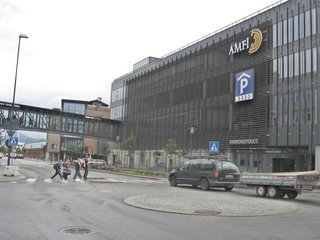 Vinmonopolet, the largest establishment in dreary Sandnes
Vinmonopolet, the largest establishment in dreary SandnesNearby was a traditional wooden house open to visitors so we took a peep. Inside was an art exhibition organised by a Norwegian lady and her English partner. He was only too eager to talk with his fellow countrymen. He told us he had a place in Spain near Benedorm where he'd recently met Ingrid. He's sold up in England and had developed the habit of travelling the word, returning to Spain for the winter. He was here for three months helping Ingrid with her exhibition and had recently returned from six months in Australia. He also gave us a rundown on the world economy based on the cost of beer in different parts of the world. It is curious the many different ways people we have met over the year have treated retirement and the unexpected way their lives often work out. Ingrid assured us that prices here are amongst the highest anywhere but that salaries are also high to compensate. We are now trying to understand how Norway will be in a position to transfer to the euro when there appears to be something wrong with the level of the exchange rate between Norway and the rest of Europe.
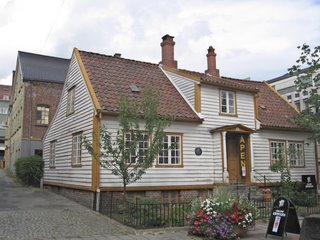 Wooden house with art gallery, Sandnes
Wooden house with art gallery, SandnesAround lunch time we reached the outskirts of Stavanger where there was a marathon in progress with traffic held up by the runners. (That will bring in a good few extra kroner at the next timed road toll!) We made our way to this campsite on the edge of a shallow lake, a cycle ride from the town centre. After a late lunch, as the rain had stopped, we left Modestine and cycled around the lake into the town centre.
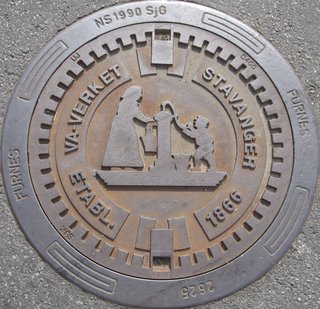 History beneath our feet, Stavagner
History beneath our feet, StavagnerStavanger is built around its deep water harbour on the fjord and of course has the ferry terminal for crossings to Denmark and Britain. We spent an enjoyable couple of hours exploring the surrounding streets where people were sitting with their beers on the terraces in front of various bars and from the Irish pub came the very Celtic sound of folk music and fiddling. There are a couple of museums which look very interesting but they will wait for tomorrow. We visited the cathedral in a park beside an ornamental lake with a large fountain. Modest in scale its Romanesque style looked rather familiar. We later discovered that it had been constructed by English craftsmen under the influence of the Bishop of Winchester in the 12th century. The town rises steeply up from the harbour and all around new blocks of flats and businesses have been built. They are large and generally unattractive. Unfortunately they dominate the skyline from all around the town. The entire centre of the town is being redeveloped in preparation for its role as European Capital of Culture in 2008.
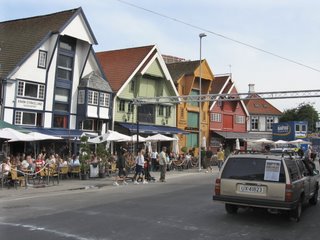 Former warehouses on the harbour, Stavanger
Former warehouses on the harbour, Stavanger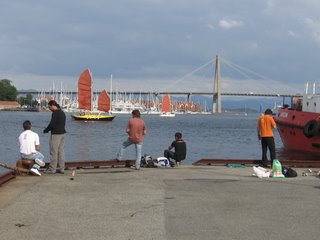 Harbour bridge, Stavanger
Harbour bridge, Stavanger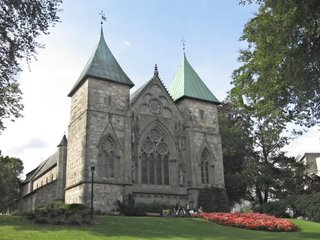 Cathedral, Stavanger
Cathedral, Stavanger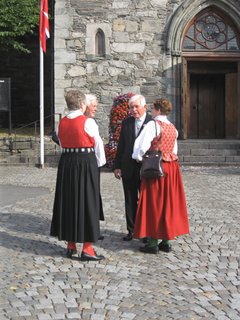 Norwegian national costume, Stavanger
Norwegian national costume, Stavanger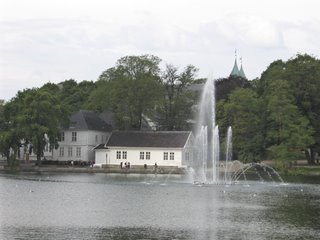 Ornamental lake seen from the Cathedral, Stavanger
Ornamental lake seen from the Cathedral, Stavanger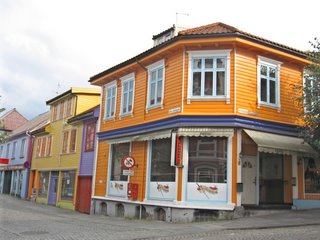 Colourfully painted wooden buildings, Stavanger
Colourfully painted wooden buildings, StavangerWe cycled along the far side of the fjord to the ferry terminal in the hope of sorting out a ferry crossing to Newcastle. The office is shut until Monday though so it will have to wait. On the way back we chanced upon a gem. Steep cobbled streets formed a little maze of fishermen's cottages, all of traditional Norwegian wood construction, each with its own little garden filled with roses, nasturtiums and hollyhocks.
 Flowery corner of old Stavanger
Flowery corner of old StavangerApparently they were destined for demolition in the 1950s but somehow they were saved. Looking at the ugly blocks just above them on the hill, it is easy to see what would have replaced them and how near the town came to losing a unique and beautiful quarter.
At different points around Stavanger stand sandblasted iron statues of a man. Each is positioned at exactly the height of the head of the previous one, forming a broken column of 23 figures descending through the town to the harbour. The sculptures are a cast of the artist Antony Gormley, also responsible in Britain for the "Angel of the North" near Gateshead.
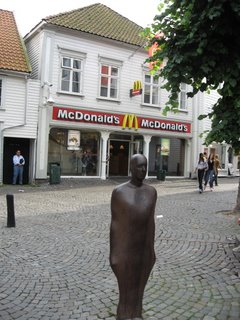 Antony Gormley pops in to a wooden McDonalds on his way to the harbour, Stavanger
Antony Gormley pops in to a wooden McDonalds on his way to the harbour, Stavanger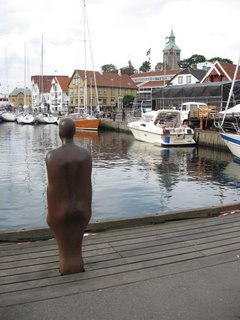 Antony Gormley watches his Big Mac wrapper float across the harbour, Stavanger
Antony Gormley watches his Big Mac wrapper float across the harbour, StavangerSunday 20th August 2006, Stavanger, Norway
Today has been relaxing and very enjoyable. After a leisurely start we cycled down into the town where there is a museum of the Norwegian fish canning industry we wanted to visit. It occupies a large 19th century wooden house above the cottages of old Stavanger and used to employ over 70 people, mainly occupied in processing and canning Norwegian brisling. These are really the same as sardines though the latter come from the Mediterranean and are larger than those found off the coast of Norway.
The museum produced its own tins, labels and packaging as well as processing the fish delivered to the factory in boxes of ice, straight from the fjords where they are caught between May and October. We found it all so intriguing we were there for nearly three hours. We were particularly fortunate that the explanatory boards were in both Norwegian and English.
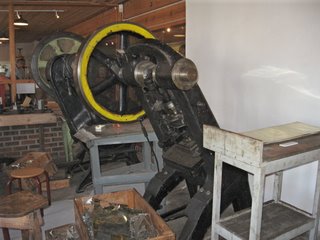 Lid making machine at the canning factory, Stavanger
Lid making machine at the canning factory, Stavanger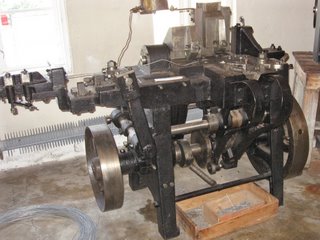 All this to make a key for a sardine tin! Stavanger
All this to make a key for a sardine tin! Stavanger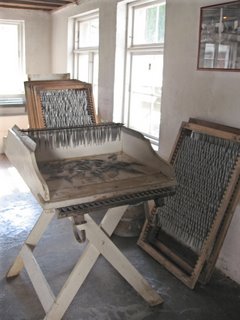 Sardines are hung in rows on skewers in a wooden frame and then then smoked for an hour before canning. Stavanger
Sardines are hung in rows on skewers in a wooden frame and then then smoked for an hour before canning. Stavanger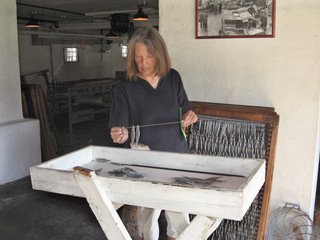 Jill tries threading sardines, Stavanger
Jill tries threading sardines, Stavanger Sardines hung in a wood-fired oven to smoke, Stavanger
Sardines hung in a wood-fired oven to smoke, Stavanger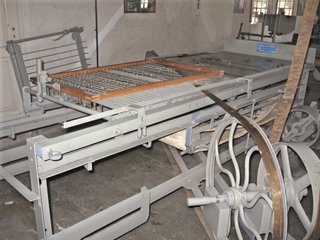 Decapitating machine once fish have been smoked and before packing, Stavanger
Decapitating machine once fish have been smoked and before packing, StavangerFish heads used for fertilizer and animal feed
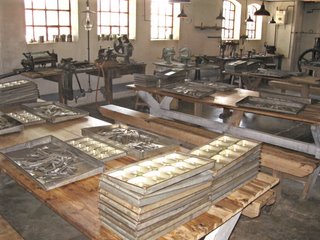 Packing of tins was done by hand at these benches, Stavanger
Packing of tins was done by hand at these benches, Stavanger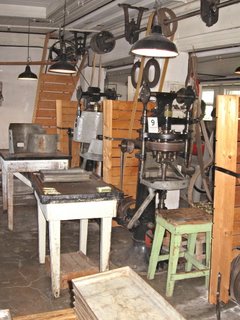 Soldering machine for fitting lids, Stavanger
Soldering machine for fitting lids, Stavanger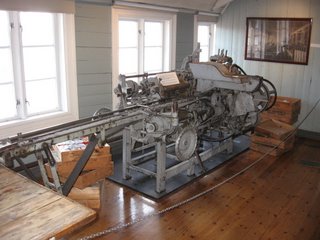 Labelling and packaging machine, Stavanger
Labelling and packaging machine, StavangerAfter canning tins are sterilised in an autoclave before passing through this final process
Norway has proved to be far too expensive for meals or drinks out, so we found somewhere to sit on the harbour beside a guarded German mine sweeper where we ate a frugal picnic we had managed to put together from our reserves in Modestine. At least we should come home slim and healthy after our two or three weeks in Norway! We were told quite definitely by the guard on the gangplank of the minesweeper that we could not go on board and have a look around so we cycled off around to the far side of the fjord up to the North Sea oil museum.
Norway really is a lead player in the oil stakes. Britain only relies on the country for 2 per cent of its supply but the rest of Europe imports up to 26 percent of its requirements from Norway. This museum really was absorbing, covering all aspects of the industry from how and why oil was to be found in the North Sea in the first place, the geological structure of the seabed, how to find likely sites to drill, and how the drilling was done. The rigs are vast structures and there are mock-ups of life on board, safety routines, coping with emergencies and disasters, a helicopter cabin simulating flight procedures between the rigs and the shore and much more. The museum included uses for oil and gas and products produced from them, including all kinds of plastics. The accompanying films left us with a sense of awe at the ingenuity and skill of scientists and technologists in taking on the might of the sea and the earth against unbelievable odds to ensure a regular flow of power and fuel to keep the world's industries and homes running. Pipelines run beneath the sea directly from Norway's off shore oil fields to terminals in mainland Europe such as Bremerhaven and Rotterdam
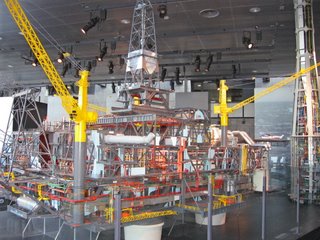 Engineer's model of a North Sea oil rig, Stavanger
Engineer's model of a North Sea oil rig, Stavanger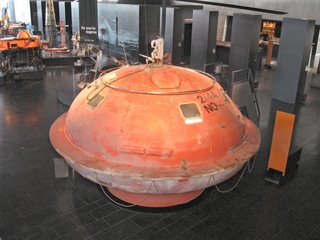 Emergency life raft for a North Sea oil rig, Stavanger
Emergency life raft for a North Sea oil rig, Stavanger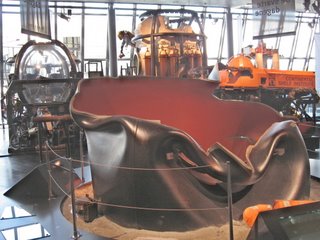 Crumpled support from a collapsed oil rig, Stavanger
Crumpled support from a collapsed oil rig, StavangerMore than 100 people lost their lives in this disaster
North Sea oil has made Norway the largest oil exporter after Saudi Arabia. Such wealth means that living standards here are high and that would seem to be a possible explanation for the high wages and high prices we are so conscious of.
After two museums today we were feeling physically weary and mentally exhausted from absorbing so much fascinating information on subjects about which we knew so little. So we were grateful to sit in an internet place for an hour transmitting another blog, sorting out bank statements and other boring matters that still need attention when travelling, and reading our emails. On weekdays we try to use libraries as internet is generally free there for thirty minutes, but on a Sunday with a large amount of data to send we had to use a normal internet café. Like most things in Norway it seemed expensive costing around £5 an hour. We could almost have shared a glass of wine for that!
We were really hungry by the time we'd cycled back to Modestine. Our meals are becoming increasingly odd as we use up tins we have had for emergencies since we were in France, mixed with whatever we have bought in the Norwegian Coop here. Tomorrow looks like being fondue with lentils unless we can find a supermarket in the wilds of the countryside as we continue our travels north. The next day might well reduce us to prizing the lid off the tin of brisling Ian bought for emergencies at the canning museum – we still have half a packet of Danish crispbread somewhere to eat with it! It is difficult to create enjoyable, healthy meals requiring the minimum of preparation and cooking in Modestine when even bread is around £3 a loaf and so is a bottle of water if you are mad enough to buy it. We have survived okay on campsite water all year with no ill effects. In France we were spoilt for choice with all sorts of cooked menus to choose from and a whole range of charcuterie. Here such things are uncommon and expensive. A packet of frankfurter sausages cost us over £5! A basic takeaway McDonald burger would cost around £5.50.
So returning to Britain will have its compensations. The ferry to Newcastle is run by Fjord lines so we cannot even look forward longingly to crossing the North Sea with a plate piled high with chip butties and a brimming tankard of Boddingtons! Once we reach Newcastle we are heading straight for a plate of fish with mushy peas! To misquote a Geordie children's song - "we shall have a fishy on a little dishy when the boat comes in"!
Monday 21st August 2006, Haugesund, Norway
We have seen some wonderful scenery today as we drove up the E39 road that stretches from Kristiansand right up to Bergen. Can there be another road anywhere that takes in such a variety of stunning views? At Stavanger it turns into a motorway for a few miles before reverting to a lonely moorland road with very little traffic. It crosses bridges, disappears down tunnels and abandons you on the edge of fjord to take a ferry after which it continues on the other shore. At times the water laps at the road on either side, so slim is the narrow neck of land it occupies as it island-hops all the way up the coast.
Our journey today has taken us through several long tunnels that either cut through the mountainside or burrow beneath the waters of the fjords. Spectacular is not the way to describe the six kilometre long Byfjord tunnel that descends in darkness 223 metres down below the surface of the sea. It is the second deepest sea tunnel in the world. Awesome is the word to reflect our sensations as we drove down through this rugged, unlined tunnel, aware of the deep, silent waters of the fjord and the mass of granite rock above us. It is quite difficult to judge speed in a steep, dark tunnel with only the dim overhead lighting and the beam of oncoming vehicles to orientate by. Even the sound of the engine changes inside the rock but eventually we reached the bottom of the steep slope and started up the far side towards the surface. The light at the further end glowed for several kilometres before we shot out into the sunshine for a few minutes, crossed the little island and disappeared back down again into another four kilometre tunnel!
 Inauspicious entry into the Byfjord tunnel
Inauspicious entry into the Byfjord tunnelFar sooner than we expected we found ourselves on the bankside at Mortavika from where a ferry carried the road across the water to Arsvågen on the island of Bokn. The ships were impressively large for an internal crossing and we drove on just as it was leaving. The crossing takes about 25 minutes and three ferries operate around the clock. We spent the crossing on the deck gazing at the beautiful and tranquil scenery as we passed little islands, heading for the heather-clad granite shore with nothing but a few sheep roaming the cliff tops and the one single road to carry traffic on northwards.
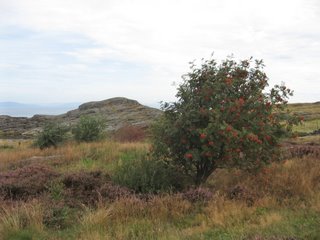 Typical scenery for much of the day
Typical scenery for much of the day Landscape on Bokn
Landscape on Bokn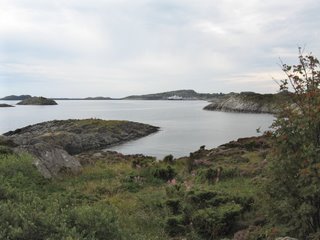 The ferry seen from Bokn
The ferry seen from BoknA short distance along the coast from the ferry we stopped to watch herons and cormorants fishing the deep clear waters of the fjord while just off shore there was a small commercial fish farm.
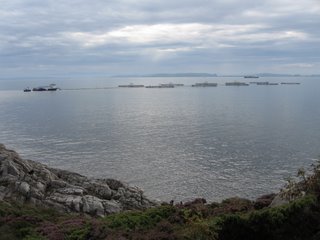 Fish farm on the Fjord at Arsvågen on the island of Bokn
Fish farm on the Fjord at Arsvågen on the island of Bokn 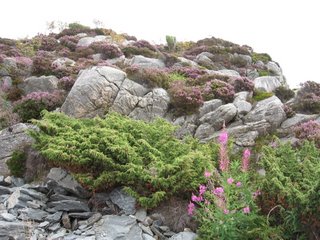 Natural rockery on the island of Bokn
Natural rockery on the island of Bokn Further round at Kårstø we saw one of the largest gas refineries in Europe. Somehow it didn't look that huge standing isolated in such a wide and beautiful landscape. It rather reminded us of the oil refinery off the Pembrokeshire coast at Milford Haven.
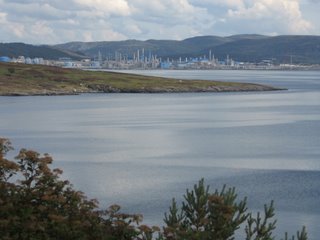 Gas refinery at Kårstø
Gas refinery at KårstøSo our route continued, tunnels, scenery, bridges, more tunnels. Mid afternoon we found ourselves in Haugesund, the only town of any size along the thinly populated west coast between Stavanger and Bergen.
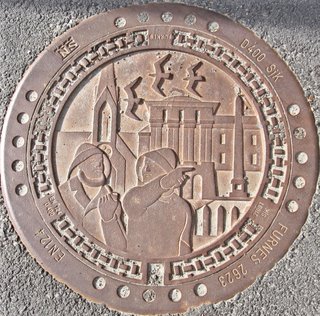 Scenes of importance around Haugesund depicted on its manhole covers
Scenes of importance around Haugesund depicted on its manhole coversHere we parked Modestine near the ferry port intending to sort out a crossing home. Nearby were parked several Polish cars and on the port is an enormous ship-building hanger. Gdansk shipbuilders would appear to be able to find work and good wages more easily in Norway than back in Poland.
Generally the port was deserted as no ships were due. We eventually found a battered door with a Fjord Line nameplate and an intercom. Stating our business the door swung open and we followed a maze of unprepossessing corridors and climbed several external aluminium staircases before finding a wooden shack-like building several floors above the ground. Inside however it was a perfectly modern office shared by the ferry company and the Danish consulate! We have now booked our crossing from Bergen on 31st August and our travels really are drawing to a close for a while.
We returned across the fjord that runs up into the heart of the town and parked for a preliminary exploration before finding a campsite for the evening. Our ferry crossing had turned out to be slightly cheaper than we had expected and with ten days still before the crossing we realised there was no way our wine supply would last out. So we searched the town until we found the Vinmonopolet. The shelves were full of wines from around the world at prices that almost made it cheaper to travel and buy your own from the supermarkets there! We are now though, the proud but bankrupt owners of a baginbox of Côtes du Rousillon which should keep us happy until we get home.
Returning through the town we saw a police car and a couple of policemen harassing two very scruffy, grey haired winos on a street bench, happily pickled with beer. How they afforded it and how they got it heaven knows, but they didn't keep it for long. Putting on a pair of black gloves one policeman confiscated the bottles while the other frisked them for any more hidden in their various saggy pockets. The police drove off with their haul leaving the two winos glumly mumbling on their bench before tottering off to investigate the contents of the nearest litter bin. Given the price of alcohol here we felt rather sorry for them. They must even have lost the various kroner due back on the confiscated bottles! We were just grateful the police didn't do a stop and search on us and discover our rucksack was full of Côtes du Rousillon!
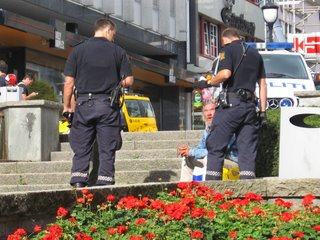 Police make life miserable for a couple of down and outs in Haugesund
Police make life miserable for a couple of down and outs in HaugesundAround 6pm we found this campsite, beautifully sited overlooking the sea which is sprinkled with islets, several with lights that are now flashing through the darkness as an aid to shipping. Right nearby stands the national monument to Harold Hårfagre or Fairhair. He is credited with unifying Norway in 872 and is supposed to be buried on the hill behind the campsite shower block.
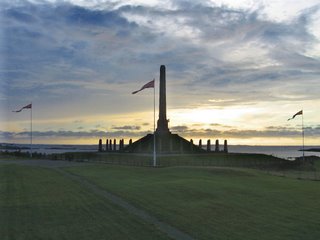 National monument to the unification of Norway on the cliff tops at Haugesund
National monument to the unification of Norway on the cliff tops at Haugesund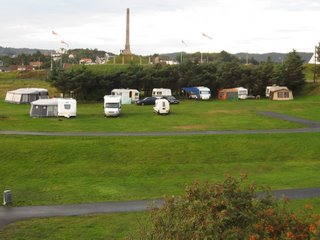 Modestine gazes with respect at the tomb of Harold Fairhair
Modestine gazes with respect at the tomb of Harold Fairhair Very early Christian cross from around 1,000 AD we discovered on the cliff top
Very early Christian cross from around 1,000 AD we discovered on the cliff top